Although European Union does not belong to the largest CO2 emitters, it has comitted itself to make biggest progress in reducing GHG emissions and to become the first Carbon-free continent. One may ask, what reasons were behind setting such a challenging target, even when compared with other countries like USA, Russia and China, what has been reached up to now could lead to quite comfortable “Sit and wait” strategy.
Instead, while EU leaders have set during the Paris Climate Agreement in 2016 their common goal in reducing GHG emissions by 40% till 2030, only four years later, during the EU Green deal, they have increased this target to 55% and even some environmental organisations and activists called for more demanding target of 60% at least. In addition, as mentioned above, European Union would like to reduce net Carbon emissions to zero level by 2050.
So, how did we come to these increasing commitments and are they realy achievable when we know how hard is to reach common consensus in much easier questions within EU policy-makers? Well, there have been couple of good reasons for such development:
- Among EU27 entities there are more than 10 most developed and richiest countries (per capita) in whole world, so it seems to be fair that we will try to contribute more as the transition phase towards to carbon free continent will be hard, time-consuming, expensive and demanding for its integration into real life.
- EU has already reached nice progress in reducing CO2 emissions till 2020 by almost 25% so when we apply more effective tools, which are currently on the table, more challenging target than only 40% may appear as reasonable.
- World most-famous environmental acitivist, Greta Thunberg is from Sweden, and as she has been attending global conferencies with world leaders, it would be a shame for EU if we had ignored this topic. On the contrary, the Climate changes have become the main public topics discussed during the elections for EU Parliament in 2019.
- And finally, EU leaders might have seen that these trends of approaching “more green policy” are simply irreversible (German “Energie-wende” policy, financial markets embracing ESG financing and more frequent changes in global weather etc.) so that it was a result of reasonable expectation which direction future policy will be heading.
European Green deal
In light of all those previously mentioned facts, it was no big surpise that EU policy-makers came to conclusion that previous commitments concluded within Paris Climate Act were not ambitious enough and that Europen Union could play some leading role in common effort to substantially reduce GHG emissions. Therefore, all EU prime ministers have met shortly before end of year 2020 and signed EU Green deal, whose main goal was to reduce emissions by 55% at least until 2030 (based on that Fit for 55 strategy was orchestrated). This target was naturally certain political compromise, while some activists incl. Greenpeace have requested target from 40% (under Paris agreement) to be increased up to 60%. In addition, another very ambitious plan has been laid-out how to reach Carbon neutrality by 2050, which included following items:
a) Cyclical economy – reducing waste and purchase of one-off products instead of using recycled products in order to cut PVC and other materials usage within the production cycle,
b) Renewable energy sources – prefering the “clean” energy in production mix and thus supporting the Energy Transmission process (e.g. shutting down the coal mines and focusing on solar, wind and water-farms production). This is a complicated topic so that there will be dedicated Section analysing further details.
c) Electromobility support – reducing fossil fuels consumption while preferring EV cars or another alternative fuels like Hydrogen. This new direction in car production sector is partially outcome of previous scandals like “Diesel-gate” so that all leading brands have launched production of fully-rechargable or at least hybrid cars with intention to “optimize the negative PR” from those affairs. However, it is also well connected with Energy transmission topic, whereas there will be higher demand for availability of recharging premises, so that it will go hand in hand with each other. More details will be also discussed in separate Section.
d) Integrated public transport – creating optimalized model for cross-country connectivity while respecting Customers needs and looking at costs and environmental effects of such policy.
e) Carbon Tax and Carbon Price floor to be implemented – additional incentive/penalty system for CO2 emitents. This has been designed by European Commission just recently, although such policy may represent most effective one-off tool for reducing GHG Emissions, it is also very sensitive issue and may require more “positive PR” before it gets applied. For explanation of Carbon Tax, please refer here.
f) Civic housing reconstruction – Top down solution to be applied when building or re-constructing the houses and residential premises (solar pannels on roof, rain water collection system, waste water recyclation, alternative energy heating systems etc.). This is aimed to prevent from energy losses with older housing units, so that they could become less economic-demanding, when it comes to operation costs.
When reading the list of these milestones one must admit that this whole package represents radical change in our mind-sets waiting to take place somewhere in near future. To some extent we may have a feeling that we will be facing a major experiment since establishing the single union in Europe. And what is clear now, that there is not absolutelly same opinion of all EU member states on these topics, especially when it comes to Energy production mix as some countries are less and other are more rellying on coal energy, for instance. On top of that, the discussions about nuclear energy will be very tough, after Fukushima tragedy and Germany resistance. However, Germany has very good location and can benefit from heavy winds from Baltic sea (for wind-power stations), so that it became one of the first country to produce more than 50% of energy purely from renewables.
On the other hand, everyone knows that renewables (like solar, wind and water energy productions) are quite volatile depending on stability of the weather, so that if Europe is supposed to be preferring these energy-sources in future, it must have also some back-up plan for energy black-out situations. And this will require deeper coordination or even maybe to agree on common Energy policy for EU. For instance, during the 1H2021 there were two potential black-outs almost taking place in whole Europe, and the upcoming winter will be also quite demanding due to natural gas shortages from Russia and increasing market prices of energies, as such.
So, EU has pledged to play leading role in this effort, but its share on global CO2 emissions is not so much critical, when compared with its rivals. And therefore, lets have a look at the rest of the world.
USA and its U-turn
As mentioned previously, after the presidential election in late 2020, United States of America have re-joined the Paris Climate Act and started to heavily support other related initiatives with the rest of the world. But, it was not due to the fact that Fight for climate became a new fashion, but because USA were never isolated from the global problems caused by climate changes.
The floods and storms accompanied with hurricanes, and recently also wild-fires have been representing regular threats to civil lives and properties, as well. According to US Oceanic and Atmospheric Administration, only the floods and storms showed increasingly devastating statistics:
- In the 1980s in average of 3 weather disasters p.a. (with property damages and rescue costs of $17.8 bln);
- by the 2000s the events had grown to 6 disasters per year ($52 bln).
- In the 2010s in average of single event per each month ($81 bln).
Next to it, the single weather disasters in latest period have carried even higher price tag for their economic losses caused. In particular, the Hurricane Katrina that hit New Orleans in 2005 had killed 1,800 people and tallied up to nearly USD 160 billion in damages. The second and third most damaging hurricanes were Harvey and Maria (in 2017) that issued a bill of USD 97 billion resp. USD 69 billion. Based on that we may conclude that Americans feel the consequences of global warming literally every day.
In addition, during the hot and dry summers, the wild-fires have been seen as regular disaster event caused by weather but also very obsolete technical shape of U.S. electric network. For instance, Pacific Gas & Energy Corp., the California state’s largest utility, tumbled into bankruptcy after its equipment sparked fires that killed more than 100 people and destroyed thousands of homes in California in 2019. The utilities company had to settle the claims on casaulties and property damages for $25.5 billion.
Based on that we may conclude that Joe Biden administration decided to move towards the proper direction, when it had announced substantial investments into the fight for climate. This package has been mainly built based on three pillars, which should be sufficient to gradually reduce CO2 Emissions, at least in short/mid-term horizon:
- Decarbonization of Energy transmission network and Reduction of Fossil Fuels (Coal and Oil) for heating purposes,
- Electromobility preference,
- Carbon Tax application.
According to latest studies prepared by Bill Gates Foundation, a fully integrated and modernized energy network could cost about $1.5 trillion, which could help to reduce U.S. emissions by 42% till 2030, representing substantial progress.
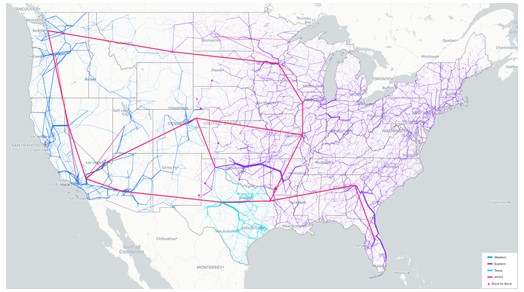
Such integrated network connecting east coast of USA with western coast could benefit from different time zones, so that solar-pannel energy produced in Texas during the day could help to subsidize the energy-shortages in New York or in San Frascisco (very simplified explanation). Naturally, this is expected to be supported by massive scale-up of wind and solar farms throughout the country. Another positive aspect of decarbonized grid system will be in more resilient network to extreme weather events.
Further, Joe Biden has recently presented a package for Electromobility support, which counts with total subsidies of USD 174 billion to be spent in many ways. Among others, new 500 tsd. recharging stations
for EV cars across USA should be built in order to boost signifficantly important transition process towards more environment-friendly vehicles. This seems to be a key element in broader climate goals, as Transportation industry alone generated 29% of all Carbon emissions in 2019, representing the main contributor among other business in USA.
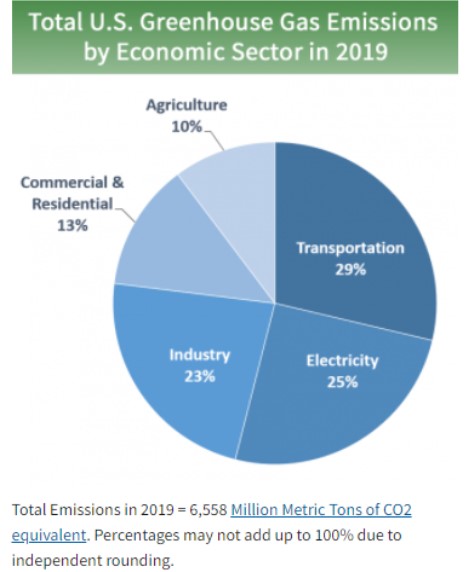
In addition, current Administration is willing to apply purchase incentives to customers in form of consumer rebates (USD 100 billion roughly), but also corporates in order to speed-up the sales of EV and plug-in hybrid vehicles that should make up to the half of all new cars sales by 2030 (current level of 300 tsd newly registered electric vehicles each year is certainly laging behind China pace with 1,4 milion of a new registrations).
Naturally, the U.S. Administration has presented further ambitious plans and actualy it has also re-worked their NDC targets under Paris Climate Act, whereas it has confirmed an increased goal of CO2 reduction by 50-50% until 2030. Further, it would like to reach zero Carbon target by 2050, same as European Union. Below attached is the updated overview of NDC targets.
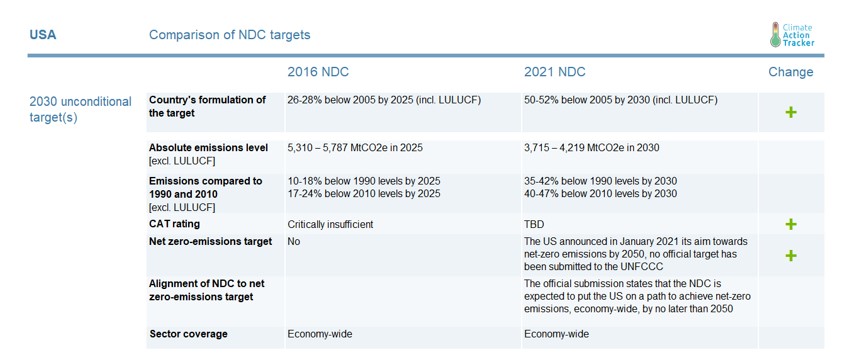
Russia – threats and opportunities
Russia is the world’s fourth-biggest emitter of greenhouse gases, and it represents the region which is warming more than twice as fast as the rest of the world, despite being homeland to more than a fifth of the planet’s forests (which should absorb CO2 and help to slow-down the warming). Due to hot and dry summers in period 2019-2020, there were two consecutive years of record-breakingwildfires that released emissions equivalent to country such as Spain, itself.
Nevertheless, Russian policy-makers and Industry captains are not so concerned about global warming and instead they may even see some business opportunity, there.
As it is facing rapidly rising temperatures in area of the Arctic sea, talks about opening the Northern Sea Route (which links northern Europe and Russia to China), have been progressed up to the realisation stage. In the past, it used to be blocked by ice most of the year, with navigation only possible in summer months, from June to October. In 2020, record-low sea ice and an increasingly powerful Russian fleet of icebreakers meant the season was stretching from May to February. Given that, Russia is getting ready for full season operation and is betting that demand for transportation needs will rise over the coming decades.

It is due to fact that Russia keeps the world’s largest reserves of liquified natural gas (LNG) and melting ice in the Arctic means it can ship more of its export to other countries. LNG burns cleaner than coal or oil (though it still releases minor emissions), so that they expect that more countries will have to replace coal with gas in order to lower their carbon footprints. And such business activity will help to pour in more money into Russian federation budget, that is expected to face more shortages in near future. This is due to the following facts:
a) Energy transition process will lead to signifficantly lowered global demand for Oil, which is one of the largest contributor to Russian Export sales being above 40% on total;
b) Global Oil prices are under OPEC influence, whereas other member countries like Saudi Arabia, Kuwait, Iran etc. will be under pressure to cut CO2 emissions and hence their weakend future coordination for regulated supply may reduce the market price in long-term view;
c) Potential Tax-evasion efforts by main largest companies owned by Russian federation (and Oligarchs) when their Sales should fall and thus negativelly affecting Tax income for State Budget.
Based on that, it seems quite unrealistic that Russian Government would be able to find sufficient funds to finance the transition process in their country or even to find any political support for such changes. On the other hand, we must understand that any climate goals are hardly achievable in such large area landscape like Russia, as in some area density of population is only one citizen per 1sq km.
However, Russia itself may face very negative development in connection with global warming. This is due to the fact, that Permafrost, the frozen ground covering about half of Russian land incl. The Siberian tundra keeps melting due to higher temperature. As it stores an estimated 1,700 gigatons of planet-warming carbon dioxide and Methan (twice the amount currently in the atmosphere), it represents major threat as these gases could be released into the air gradually, if the ground totally unfreezes. And such a risk puts the global warming into totally new perspective.
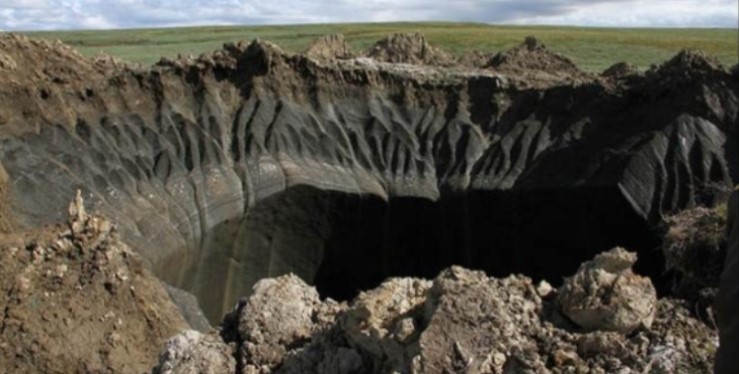
source: The Siberian Times
So in the end, if not environmental aspects itself, the financial markets could force Russian entities to jump on the transition train (see the details in another section covering the Energy transition process), so that this fight may not be lost, yet.
China – on its own Transition way
This is the single biggest annual carbon emitter, but also a producer of clean energy related products, thus representing signifficant game changer. Under “BAU” conditions, it would be only able to reduce carbon emissions by a little 10% till 2050 (while other Nations would have to cut emission by >75% to offset this shortfall). However, we cannot conclude that China does not understand the needs for Energy transition world-wide and that it is totally ignoring such process.
Massive urbanization of large cities in last decades has brought energy consumption up, so far Coal makes still 60% of energy production mix, and installation of new Coal power plants continues (total output of newly built facilities since 2000 accounted for 940 GWh), so that it is not very pragmatic to expect that China will shut down the coal power plants just like that. And further, Steel and cement factories make over 50% of total production output, and they are widelly known to be connected with very high emissions and low effectivity in terms of energy waste etc.
On the contrary, the China officials are well aware of unsustainable situation regarding the bad climate in large cities, which has adverse effect on nations health and has already brought on the attention to Government criticism by public. According to some statistics, there has been done some partial improvement, but obviously the system change is needed.

source: Dialogonchina.net
Given the increased usage of personal cars (up by 100% in last 10YRS), China naturally focuses on electro-mobility and production of batery cells, clean energy alternatives for transportation industry (hydrogen etc.). So, it would represent a big surprise, that China would not wish to benefit from these modern technologies, even when it was able to bring them on market. Currently, the number of EV cars sold there ranges between 50-70% on world-wide sales with annual 1,4 milion units (as per 2020), market leaders represent brands solely focused on EV cars like BYD Company Ltd, SAIC Group, NIO, Li Auto, Geely etc.
In finance area, China central bank also works with EU on green investing standards with aim to have national carbon emissions peak before 2030 and become carbon neutral by 2060. Assumed investments should be up to $15 trillion through 2050 to reach the 1.5°C target (or the equivalent of about 2% of China’s cumulative GDP). Their updated NDC list with ratified targets from Paris Climate Act is below attached.
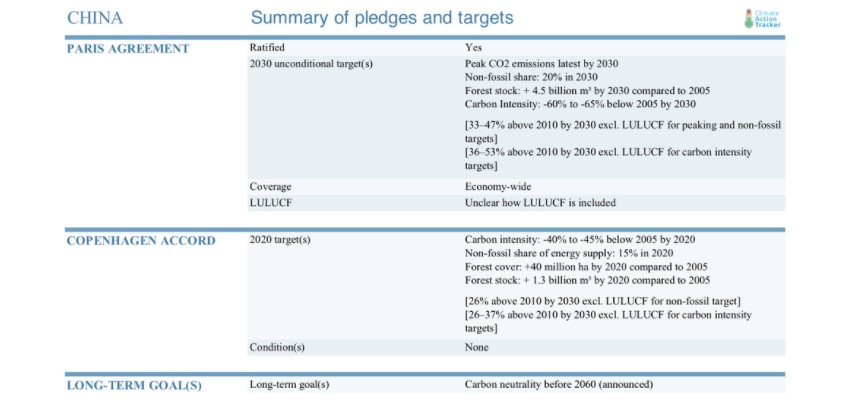
Fit for 55 Strategy
The European Commission published this summer the package known as ‘Fit for 55’ representing a complementary package of a dozen legislative proposals, that are intended to support the transition process of whole European Union towards the Carbon-free continent, as it was concluded within the EURO Green Deal.
Given the very ambitious target of 55% GHG Emissions reduction, an update of the numerical targets for existing policies was needed, among others as follows:
- EU emissions trading system (ETS) – whereas the revision of the rules aviation industry will be needed, also extension to shipping industry and establishing a new rules for road transportation industry and other emitters (like buildings etc.),
- effort-sharing for non-ETS emissions – a revision of EU members states targets (NDC) outside ETS relevant sectors,
- land use and forestry (LULUCF) – an update on regulation whereas the whole land sector will be covered from 2031 by including non CO2 agriculture emissions newly; in addition by 2030 delivering a removals of 310 milion tonnes of CO2 equivalent emissions removals from LULUCF sector.
- renewable energy, energy efficiency – setting a new target for energy production mix solely from renewables by 40% (up from 32%) to be achieved since 2030 and strenghtening the bioenergy sustainability criteria,
- new cars emissions standards – during the transition period from 2021 to 2030 the new cars emissions to be cut by half at least, and after 2035 even net zero emissions to be achieved.
Just from a very first look, afore mentioned plans are more complex and going into various layers of different industries involved in CO2 emissions production, when compared with simple plan outlined by U.S. Administrative, for instance. From a long-term perspective it is definitelly good, that EU members were able to agree on some long-term vision, however given the shrinking time window that we have for reverting the negative trends, it seems questionable if there is enough space for such complicated approach? Also knowing the previous bureaucracy standards within EU and unfriendly perception of local governments, public and businesses for a new regulation, this may take longer to understand the necessity and urgency of designed changes.
Fit for 55 package was agreed in most recent meeting of EU leaders in Slovenia this summer, upcoming event held by UN for Climate Change will be COP26 in Glasgow running at the beginning of November 2021, whereas interim trends and updates by all parties comitted to Paris Climate Act are supposed to be shared. For sure, main topic of all discussions will be subject to latest Climate report by IPCC pre-released this summer, which has revealed substantial shortcomings for not beeing on the track to meet 1.5° Degrees target, so far.
sources: www.un.org, www.bloomberg.com, www.ipcc.ch, www.climatecentral.org, www.europarl.europa.eu, www.epa.gov, www.climate-tracker.com